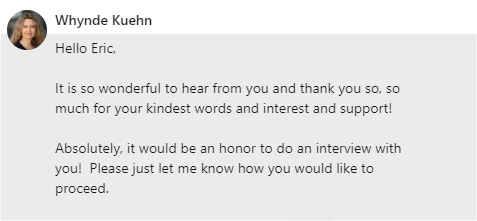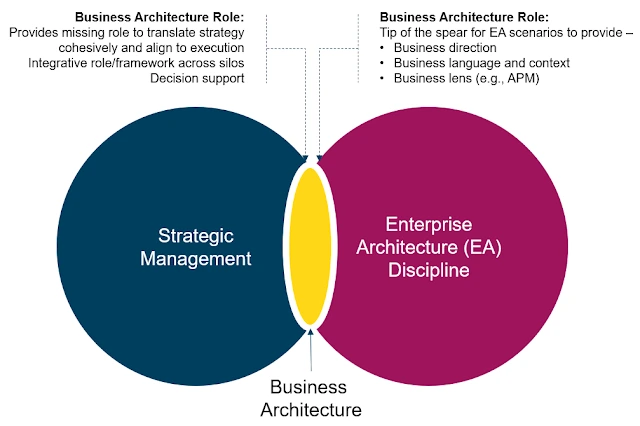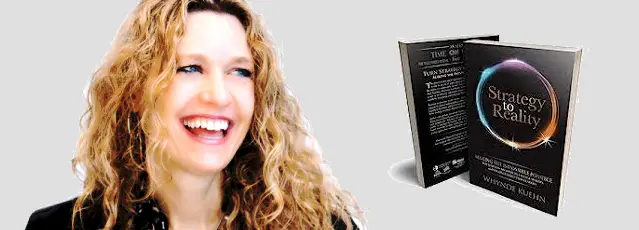I recently had the honor of speaking with Whynde Kuehn, author of Strategy to Reality. We have been connected on LinkedIn since the release of her inspiring book on turning business strategy into reality. As I was contemplating the topic of my next blog, I thought why not ask Whynde for a quick interview.
So, in the spirit of fortune favoring the bold, I sent her a message asking if she’d be willing to participate in a short interview. She agreed.

Who is Whynde Kuehn
Whynde is a long-time Business Architecture practitioner, thought leader, educator, advocate, and community builder, who has practiced the discipline from just about every angle you can imagine. From leading enterprise-wide business transformations, to managing her own team of 100 business architects, to leveraging the discipline for cross-sector collaborations across nations. Today, her focus is on helping organizations to build their capacity for end-to-end strategy to execution and build their strategic business architecture practices. Whynde loves making a difference and helping people.
To get an even closer look at Whynde, please watch this video.
Strategy to Reality
Her book, Strategy to Reality, is a unique manifesto for Business Architects, executives, and change makers to strengthen their strategy execution, decision making, and organizational and ecosystem design. It provides a practical approach to leveraging Business Architecture and is considered a must-read for any Business or Enterprise Architect.
The interview
Since she’s the author of the book that captivated me from start to finish because of the way she described the pragmatic application of Business Architecture, I thought it would be a good idea to ask Whynde some questions about the field of (Business) Architecture.
The interview with Whynde Kuehn is divided into two parts. The first set of questions will be posted on this blog, the remaining six questions will be posted in a future blog.
Here we go!
Q1. Would you please introduce yourself to the readers of my blog? Who is Whynde and what drives her to make such a huge commitment to the field of Business Architecture on a daily basis?
Having had the opportunity to work with organizations around the world in all sizes, industries, and sectors, I observed that they all shared a similar challenge: how to successfully turn big ideas into action. I fell in love with this gap and the power of clear intent translated into organized effort to bridge it – what I call turning strategy into reality.
So, the way I look at it is: every day I wake up and serve a global vision and community around cohesive, end-to-end strategy to execution and the intentional design of organizations, enabled by Business Architecture. I am a catalyst and changemaker for new ways of thinking and doing business. That is really who I am and what drives me.
I am passionate about the field of architecture, and I can’t help myself!
Whynde Kuehn
Q2. What prompted you to write your book Strategy to Reality? What was the most difficult part or topic of the book to describe?
The book was born in a flash moment that I can still remember. I had been writing a twice-monthly series called Business Architecture Straight Talk and was not sure when I would end it. I decided in that moment to end the series with the 100th installment, and to write a book to celebrate and culminate the four-year journey.
However, once I started writing Strategy to Reality, I realized the magnitude of what the book meant to me. I had a deep desire to share my knowledge and experiences with people, to help them put the pieces together and accelerate their journeys. I wanted to simplify business architecture, make it practical, and humanize it. On top of that, I wanted to create a common foundation of understanding on the contemporary practice of Business Architecture and open up new conversations on its relevance within a strategic business context.
I wanted to create a go-to reference that people could hold in their hands, whether they were a new practitioner seeking to learn, an experienced architect seeking to calibrate, or someone in an executive or complimentary role just looking to learn a little bit more. I always felt like I was writing our book, and a bit of an homage to the global Business Architecture community.
The most difficult part of writing Strategy to Reality was Chapter 1. In the spirit of making the book a reference, I wanted the chapter to be a self-contained summary of the key topics. This put more pressure on it for me. In addition, it is still challenging to describe what Business Architecture is in an engaging way for different audiences yet stay true to the discipline. I believe this is because holistic and structured thinking comes naturally to some people, but for many others it is a different way of looking at business. In addition, where Business Architecture really shines is in the why, and how organizations can leverage it for business value.
I would like to see more focus on architectural thinking for everyone (beyond the architects).
Whynde Kuehn
Q3. I have read your book (obviously) and I can taste the passion for the field of architecture reading between the lines. What makes you enjoy writing and talking about this topic or field so much?
I am indeed passionate about the field of architecture, and I can’t help myself!
First, there is a congruency with how I think and how I look at the world from a systemic and big picture perspective. In fact, my university degrees are in science and sustainability. Second, I have a lot of conviction for these ideas because I have seen them work successfully again and again around the world. I witness Business Architecture practitioners advance in their careers, strategic Business Architecture practices scale, and organizations adopt new visions for end-to-end strategy to execution and architecture-led transformation. I see the vast potential for architecture, and in our digital, connected world, I think architecture has never been more important to help our organizations and societies make good decisions and create a future we all want to live in.
Being a teacher by nature, lifting other people up and help them to succeed is true joy for me.
Q4. In the Netherlands (and presumably also in many other countries), the field of architecture is still seen as an IT capability. Personally, I have been fighting this image for years. What is your experience with the positioning of the discipline?
I do see the field of architecture is still often perceived as an IT capability (worldwide), but I also get to see a very different segment of reality from the Business Architecture perspective. For years now, we have seen a trend of more Business Architecture teams reporting to business leaders (e.g., in strategy or transformation) and being positioned up front in a role to inform and translate strategy and support business decision-making.

The contemporary practice of Business Architecture has become a bit of a Venn diagram1. It crosses, and bridges, two worlds: on one side strategic management and on the other side the Enterprise Architecture discipline. Business Architecture plays a role in the middle as a part of both and needs to cover a spectrum of usage scenarios from business to technology. Since Business Architecture is part of the Enterprise Architecture umbrella, this provides a tremendous opportunity for strategic repositioning and new relevance for architecture overall.
Q5. What topic within the context of architecture (or Business Architecture) is still insufficiently highlighted in your view? What would it take to bring that further to the surface?
I would like to see more focus on architectural thinking for everyone (beyond the architects). This includes business and technology executives and a wide range of organizational roles who can consume architecture. This also includes university students, especially within business programs.
Taking architecture to a broader audience would require further simplifying and distilling the essence of what architectural thinking means and how architecture can be leveraged within the context of enabling strategy execution and how we design organizations. Tool support becomes even more critical as well to make architecture engaging, easy, and insightful to a wider range of consumers.
Furthermore, this would require us to come together as an architecture community with more intent and clarity around the value proposition of architecture and how best to make it usable for and valuable to others.
To be continued
I asked Whynde six additional questions. Her answers to these questions will be posted in an upcoming blog.
1 A Venn diagram is an illustration that uses circles to show the relationships among things or finite groups of things. Circles that overlap have a commonality while circles that do not overlap do not share those traits. Venn diagrams help to visually represent the similarities and differences between two concepts.







Leave a Reply